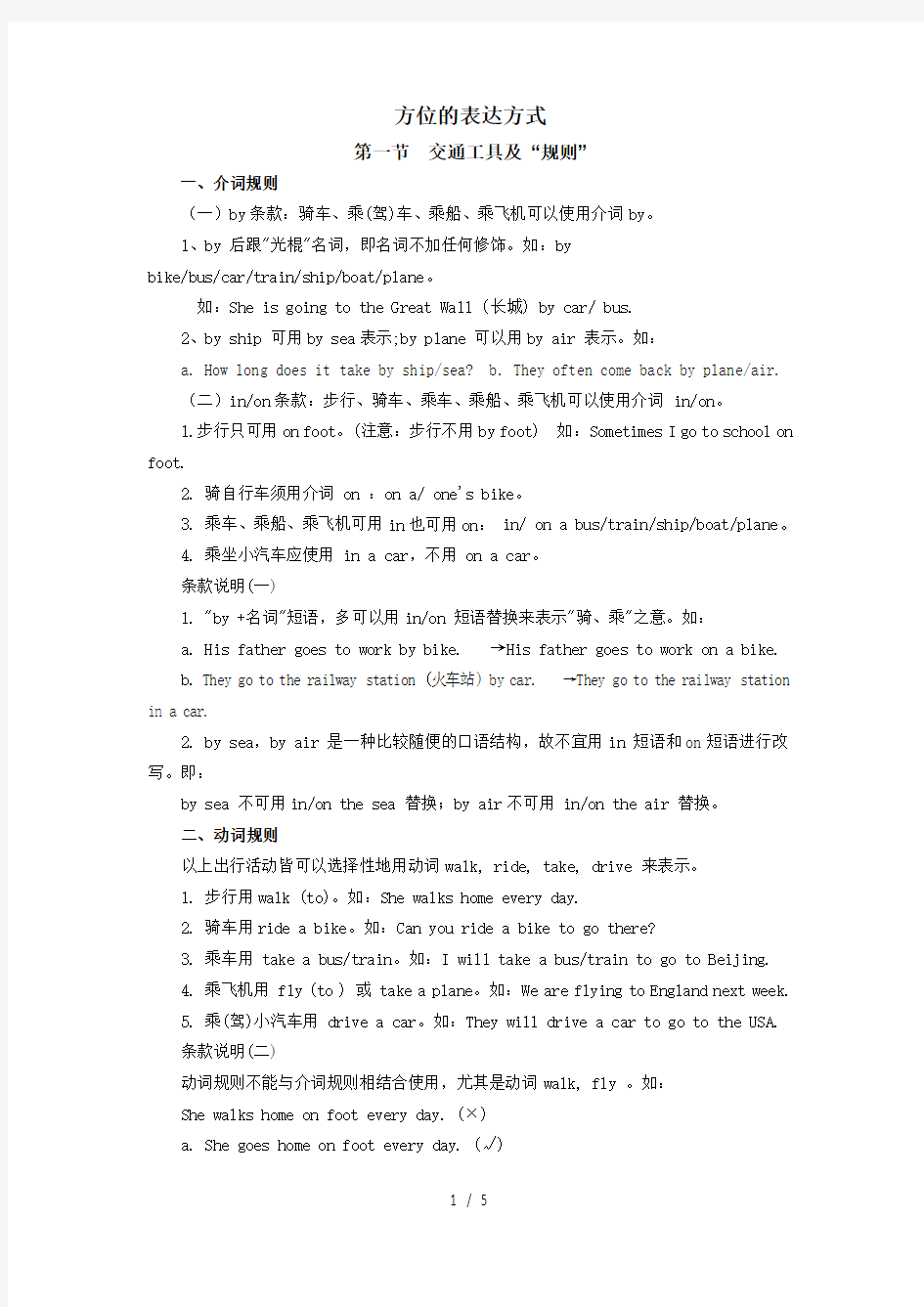小学英语方位的表达方式

- 1、下载文档前请自行甄别文档内容的完整性,平台不提供额外的编辑、内容补充、找答案等附加服务。
- 2、"仅部分预览"的文档,不可在线预览部分如存在完整性等问题,可反馈申请退款(可完整预览的文档不适用该条件!)。
- 3、如文档侵犯您的权益,请联系客服反馈,我们会尽快为您处理(人工客服工作时间:9:00-18:30)。
方位的表达方式
第一节交通工具及“规则”
一、介词规则
(一)by条款:骑车、乘(驾)车、乘船、乘飞机可以使用介词by。
1、by 后跟"光棍"名词,即名词不加任何修饰。如:by
bike/bus/car/train/ship/boat/plane。
如:She is going to the Great Wall (长城) by car/ bus.
2、by ship 可用by sea表示;by plane 可以用by air 表示。如:
a. How long does it take by ship/sea?
b. They often come back by plane/air.
(二)in/on条款:步行、骑车、乘车、乘船、乘飞机可以使用介词 in/on。
1.步行只可用on foot。(注意:步行不用by foot) 如:Sometimes I go to school on foot.
2. 骑自行车须用介词 on :on a/ one's bike。
3. 乘车、乘船、乘飞机可用in也可用on: in/ on a bus/train/ship/boat/plane。
4. 乘坐小汽车应使用 in a car,不用 on a car。
条款说明(一)
1. "by +名词"短语,多可以用in/on 短语替换来表示"骑、乘"之意。如:
a. His father goes to work by bike. →His father goes to work on a bike.
b. They go to the railway station (火车站) by car. →They go to the railway station in a car.
2. by sea,by air 是一种比较随便的口语结构,故不宜用in 短语和on短语进行改写。即:
by sea 不可用in/on the sea 替换;by air不可用 in/on the air 替换。
二、动词规则
以上出行活动皆可以选择性地用动词walk, ride, take, drive 来表示。
1. 步行用walk (to)。如:She walks home every day.
2. 骑车用ride a bike。如:Can you ride a bike to go there?
3. 乘车用 take a bus/train。如:I will take a bus/train to go to Beijing.
4. 乘飞机用 fly (to ) 或 take a plane。如:We are flying to England next week.
5. 乘(驾)小汽车用 drive a car。如:They will drive a car to go to the USA.
条款说明(二)
动词规则不能与介词规则相结合使用,尤其是动词walk, fly 。如:
She walks home on foot every day. (×)
a. She goes home on foot every day. (√)
b. She walks home every day. (√)
He will soon fly to London by plane/air. (×)
a. He will soon fly to London. (√)
b. He will soon go to London by plane/air. (√)
第二节英语中方位的表达方式
一、in, to, on和off在方位名词前的区别
1. in表示A地在B地范围之内。如:Taiwan is in the southeast of China.
2. to表示A地在B地范围之外,即二者之间有距离间隔。如:Japan lies to the east
of China.
3. on表示A地与B地接壤、毗邻。如:North Korea is on the east of China.
4. off表示“离……一些距离或离……不远的海上”。如:New Zealand lies off the
eastern coast of Australia.
二、汉语里“东南西北”的先后顺序到英语里就变成了north,south,east,west;
并由此有了下列中、英文表达上的差异。
东南方:southeast 西南方:southwest 西北方:northwest 东北方:northeast
如:十三陵位于北京西北50公里处。The Ming Tombs are located about 50 km to the
northwest of Beijing. 天津位于北京东南120公里处。Tiajin is situated l20 km southeast of Beijing.
三、 near, by, beside, at表示“在……附近”时的区别
1. near表示相对的近,实际距离可能还很远。如: Suzhou is near Shanghai.
2. by和beside都表示靠近,实际距离不可能很远,但beside比by更具体地表示出
“在……旁边”的意思。如:He was sitting beside her.
3. at也有“在旁边”的意思,但多表示有目的的行为所处的位置,而by和beside仅
表示位置关系。如:The students are sitting at the desks listening to the teacher.
四、at, in和on表示地点时的区别
1、at表示地点:
(1)用于指较小的地方。如: I shall wait for you at the station.
(2)用于门牌号码前。如: He lives at 115 Zhongshan Road.
2、in表示地点:
(1)用于指较大的地方。如: He lives in Shanghai.
(2)虽然是很小的地方,如果说话人住在那里,也可用in。商店、学校、机关等,若
看作一个地点(point)用at,若看作一个场所(place)用in。如:
I met him at the post-office. I’m now working in the post-office.
3、on表示地点,一般指与面或线接触,意为“在……上;在……旁”。如:
